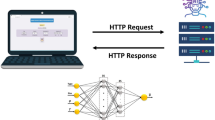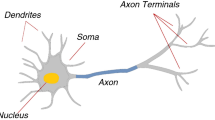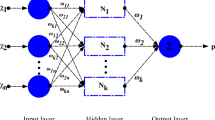Abstract
A new methodology, namely, artificial neural network (ANN) approach was proposed for modeling and predicting flow behavior of the polyethylene melt through nanochannels of nanoporous alumina templates. Wetting length of the nanochannels was determined to be a function of time, temperature, diameter of nanochannels, and surface properties of the inner wall of the nanochannels. An ANN was designed to forecast the relationship between the length of wetting as output parameter and other aforementioned parameters as input variables. It was demonstrated that the ANN method is capable of modeling this phenomenon with high accuracy. The designed ANN was then employed to obtain the wetting length of the nanochannels for those cases, which were not reported by the wetting experiments. The results were then analyzed statistically to identify the effect of each independent variable, namely, time, temperature, diameter of nanochannels, and surface properties of the inner wall of nanochannels as well as their combinations on the wetting length of the nanochannels. Interesting results were attained and discussed.




Similar content being viewed by others
References
Aamer KA, Stafford CM, Richter LJ, Kohn J, Becker ML (2009) Thin film elastic modulus of degradable tyrosine-derived polycarbonate biomaterials and their blends. Macromolecules 42:1212–1218
Ahadian S, Kawazoe Y (2009a) An artificial intelligence approach for modeling and prediction of water diffusion inside a carbon nanotube. Nanoscale Res Lett 4:1054–1058
Ahadian S, Kawazoe Y (2009b) Evaluation of the Cox equation to derive dynamic contact angle at nanopores imbibition: a molecular dynamics study. Mater Trans 50:1157–1160
Ahadian S, Kawazoe Y (2009c) A molecular dynamics approach to examine the kinetics of the capillary imbibition of a polymer at nanoscale. Colloid Polym Sci 287:961–967
Ahadian S, Moradian S, Sharif F, Tehran MA, Mohseni M (2007) Application of artificial neural network (ANN) in order to predict the surface free energy of powders using the capillary rise method. Colloids Surf A 302:280–285
Ahadian S, Moradian S, Sharif F, Tehran MA, Mohseni M (2008) An artificial neural network approach to capillary rise in porous media. Chem Eng Commun 195:435–448
Bechelany M, Bernard S, Brioude A, Cornu D, Stadelmann P, Charcosset C, Fiaty K, Miele P (2007) Synthesis of boron nitride nanotubes by a template-assisted polymer thermolysis process. J Phys Chem C 111:13378–13384
Berdichevsky Y, Lo YH (2006) Polypyrrole nanowire actuators. Adv Mater 18:122–125
Bishop CM (1995) Neural networks for pattern recognition. Clarendon Press, Oxford
Bonaccurso E, Butt H, Craig VSJ (2003) Surface roughness and hydrodynamic boundary slip of a newtonian fluid in a completely wetting system. Phys Rev Lett 90:144501
Bonn D (2001) Wetting transitions. Curr Opin Colloid Interface Sci 6:22–27
Bonn D, Ross D (2001) Wetting transitions. Rep Prog Phys 64:1085–1163
Bonn D, Eggers J, Indekeu J, Meunier J, Rolley E (2009) Wetting and spreading. Rev Mod Phys 81:739–805
Cahn JW (1977) Critical point wetting. J Chem Phys 66:3667–3672
Chen X, Cao G, Han A, Punyamurtula VK, Liu L, Culligan PJ, Kim T, Qiao Y (2008) Nanoscale fluid transport: size and rate effects. Nano Lett 8:2988–2992
Cho SI, Lee SB (2008) Fast electrochemistry of conductive polymer nanotubes: Synthesis, mechanism, and application. Acc Chem Res 41:699–707
Demuth H, Beale M (2002) Neural network toolbox user’s guide, version 4. The MathWorks Inc, Natick
Dimitrov DI, Milchev A, Binder K (2007) Capillary rise in nanopores: molecular dynamics evidence for the Lucas-Washburn equation. Phys Rev Lett 99:054501
Draper NR, Smith H (1998) Applied regression analysis. Wiley, New York
Duch W (2003) Coloring black boxes: visualization of neural network decisions. Proc Int Joint Conf Neural Netw 3:1735–1740
Duch W, Setiono R, Zurada JM (2004) Computational intelligence methods for rule-based data understanding. Proc IEEE 92:771–805
English D, Luckett C, Jayaraman K, Lee SB, Okamoto K, Son SJ (2006) Solvent behavior in hydrophobic silica nanotubes. Mater Res Soc Symp Proc 899E, Warrendale, PA
Frenkel D, Smit B (2002) Understanding molecular simulation: from algorithms to applications. Academic Press, London
Galea TM, Attard P (2004) Molecular dynamics study of the effect of atomic roughness on the slip length at the fluid-solid boundary during shear flow. Langmuir 20:3477–3482
Gasparac R, Kohli P, Mota MO, Trofin L, Martin CR (2004) Template synthesis of nano test tubes. Nano Lett 4:513–516
Grujicic M, Chittajallu KM (2004) Design and optimization of polymer electrolyte membrane (PEM) fuel cells. Appl Surf Sci 227:56–72
Grujicic M, Zhao CL, Chittajallu KM, Ochterbeck JM (2004) Cathode and interdigitated air distributor geometry optimization in polymer electrolyte membrane (PEM) fuel cells. Mater Sci Eng B 108:241–252
Han A, Punyamurtula VK, Kim T, Qiao Y (2008a) The upper limit of energy density of nanoporous materials functionalized liquid. J Mater Eng Perform 17:326–329
Han A, Lu W, Punyamurtula VK, Chen X, Surani FB, Kim T, Qiao Y (2008b) Effective viscosity of glycerin in a nanoporous silica gel. J Appl Phys 104:124908
Hastie T, Tibishrani R, Freidman J (2001) The Elements of statistical learning: data mining, inference and prediction. Springer, New York
Haykin S (1999) Neural networks: a comprehensive foundation. Prentice Hall, New Jersey
He Y, Qian H, Lu Z, Li Z (2007) Polymer translocation through a nanopore in mesoscopic simulations. Polymer 48:3601–3606
Helmy R, Kazakevich Y, Ni C, Fadeev AY (2005) Wetting in hydrophobic nanochannels: a challenge of classical capillarity. J Am Chem Soc 127:12446–12447
Hornik K, Stinchcombe M, White H (1989) Multilayer feedforward networks are universal approximators. Neural Netw 2:359–366
Jabbarzadeh A, Atkinson JD, Tanner RI (2000) Effect of the wall roughness on slip and rheological properties of hexadecane in molecular dynamics simulation of Couette shear flow between two sinusoidal walls. Phys Rev E 61:690–699
Jayaraman K (2005) Solvent behavior in hydrophobic silica nanotubes and nanotube membranes. M. Sc. thesis, University of Maryland (Available free of charge online at http://hdl.handle.net/1903/3284)
Jayaraman K, Okamoto K, Son SJ, Luckett C, Gopalani AH, Lee SB, English DS (2005) Observing capillarity in hydrophobic silica nanotubes. J Am Chem Soc 127:17385–17392
Kong J, Yung KL, Xu Y, He L, Lau KH, Chan CY (2008) Self-organized micropatterns of high aspect ratio polymer nanofibers by wetting of nanopores. J Polym Sci B 46:1280–1289
Kong J, Xu Y, Yung KL, Xie Y, He L (2009) Enhanced polymer melts flow through nanoscale channels under vibration. J Phys Chem C 113:624–629
Lee SB, Martin CR (2002) Electromodulated molecular transport in gold-nanotube membranes. J Am Chem Soc 124:11850–11851
Li EY (1994) Artificial neural networks and their business applications. Inf Manag 27:303–313
Lu W, Punyamurtula VK, Han A, Kim T, Qiao Y (2009) A thermally sensitive energy-absorbing composite functionalized by nanoporous carbon. J Mater Res 24:3308–3312
Lucas R (1918) Ueber das zeitgesetz des kapillaren aufstiegs von flussigkeiten. Kolloid Z 23:15–22
Martic G, Gentner F, Seveno D, Coulon D, De Coninck J, Blake TD (2002) A molecular dynamics simulation of capillary imbibition. Langmuir 18:7971–7976
Martin CR (1994) Nanomaterials: a membrane-based synthetic approach. Science 266:1961–1966
McCulloch WS, Pitts W (1943) A logical calculus of the ideas immanent in nervous activity. Bull Math Biophys 5:115–133
Moghe AK, Hufenus R, Hudson SM, Gupta BS (2009) Effect of the addition of a fugitive salt on electrospinnability of poly(ε-caprolactone). Polymer 50:3311–3318
Montgomery DC, Peck EA, Vining GG (2006) Introduction to linear regression analysis, 4th edn. Wiley-Interscience, Hoboken, NJ
Rowlinson JS, Widom B (1982) Molecular theory of capillarity. Clarendon Press, Oxford
Rumelhart DE, Hinton GE, Williams RJ (1986) Learning representations by back-propagating errors. Nature 323:533–536
Sbragaglia M, Benzi R, Biferale L, Succi S, Toschi F (2006) Surface roughness-hydrophobicity coupling in microchannel and nanochannel flows. Phys Rev Lett 97:204503
Schick M (1990) Introduction to wetting phenomena. In: Charvolin J, Joanny JF, Zinn-Justin J (eds) Les Houches, Session XLVIII, Liquids at interfaces. Elsevier, Amsterdam
Washburn EW (1921) The dynamics of capillary flow. Phys Rev 17:273–283
Wen M, Wang YF, Zhang F, Wu QS (2009) Nanostructures of Ni and NiCo amorphous alloys synthesized by a double composite template approach. J Phys Chem C 113:5960–5966
Yoo S, Lee J, Holloman C, Pascall MA (2009) The effect of high pressure processing on the morphology of polyethylene films tested by differential scanning calorimetry and X-ray diffraction and its influence on the permeability of the polymer. J Appl Polym Sci 112:107–113
Yung K, Kong J, Xu Y (2007) Studies on flow behaviors of polymer melts in nanochannels by wetting actions. Polymer 48:7645–7652
Yung KL, He L, Xu Y, Kong J (2008) Phase transition of LCP fluids confined in nanochannels through MD simulation. Polymer 49:2770–2774
Zambrano HA, Walther JH, Koumoutsakos P, Sbalzarini IF (2009) Thermophoretic motion of water nanodroplets confined inside carbon nanotubes. Nano Lett 9:66–71
Acknowledgments
S. Ahadian greatly appreciates fruitful discussions with Dr. Jie Kong. The authors sincerely appreciate the staff of the Center for Computational Materials Science of the Institute for Materials Research (IMR), Tohoku University, for its continuous support of the supercomputing facilities. This study was supported (in part) by the Japan Society for the Promotion of Science (JSPS).
Author information
Authors and Affiliations
Corresponding author
Rights and permissions
About this article
Cite this article
Ahadian, S., Mizuseki, H. & Kawazoe, Y. Prediction and analysis of flow behavior of a polymer melt through nanochannels using artificial neural network and statistical methods. Microfluid Nanofluid 9, 319–328 (2010). https://doi.org/10.1007/s10404-009-0549-8
Received:
Accepted:
Published:
Issue Date:
DOI: https://doi.org/10.1007/s10404-009-0549-8




